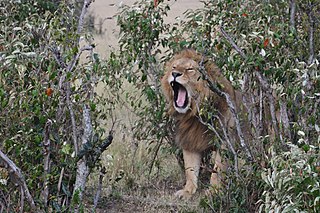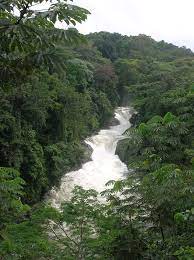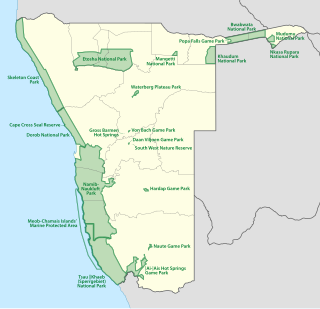
Nairobi National Park is a national park in Kenya that was established in 1946 about 7 km (4.3 mi) south of Nairobi. It is fenced on three sides, whereas the open southern boundary allows migrating wildlife to move between the park and the adjacent Kitengela plains. Herbivores gather in the park during the dry season. Nairobi National Park is negatively affected by increasing human and livestock populations, changing land use and poaching of wildlife. Despite its proximity to the city and its relative small size, it boasts a large and varied wildlife population, and is one of Kenya's most successful rhinoceros sanctuaries.

Ruaha National Park is a national park in Tanzania. The addition of the Usangu Game Reserve and other important wetlands to the park in 2008 increased its size to about 20,226 km2 (7,809 sq mi).

Queen Elizabeth National Park is a national park in the Western Region of Uganda.

Yankari Game Reserve is a large wildlife park and former National Park located in the south-central part of Bauchi State, in northeastern Nigeria. It covers an area of about 2,244 km2 (866 sq mi) and is home to several natural warm water springs, as well as a wide variety of flora and fauna. Its location in the heartland of the West African savanna makes it a unique way for tourists to watch wildlife in its natural habitat. Yankari was created as a game reserve in 1956, but later designated Nigeria's biggest national park in 1991. It is the most popular destination for tourists in Nigeria and plays a crucial role in the development and promotion of tourism and ecotourism in Nigeria. It is also a popular eco-destination in West Africa.

Kainji National Park is a national park in Niger State and Kwara State, Nigeria. Established in 1978, it covers an area of about 5,341 km2 (2,062 sq mi). The park includes three distinct sectors: a part of the Kainji Lake in which fishing is restricted, the Borgu Game Reserve to the west of the lake, and the Zugurma Game Reserve to the southeast.

Kgalagadi Transfrontier Park is a large wildlife preserve and conservation area in southern Africa.

The Selous Game Reserve, now renamed as Nyerere National Park (in-part), is a protected nature reserve and wilderness area in southern Tanzania, East Africa. It covers a total area of 50,000 km2 (19,000 sq mi), with additional buffer zones, as well. It was designated a UNESCO World Heritage Site in 1982, owing to its high levels of biodiversity and vast, undisturbed natural landscapes, such as the grasslands and the miombo woodlands habitat. Among the numerous species within the park are some of the continent's largest and most iconic, such as the bush elephant, black rhinoceros, hippopotamus, lion, leopard, spotted hyena, painted dog, Cape buffalo, Masai giraffe, plains zebra, white-bearded gnu and the giant Nile crocodile. Due to the fragility and sensitivity of the many species and ecosystems within the park, human habitation is not permitted within its bounds, and all persons entering and exiting are tallied and tracked by the Wildlife Division of the Tanzanian Ministry of Natural Resources and Tourism.

Lake Mburo National Park is a national park located in Nyabushozi County, Kiruhura District in Uganda.

India is one of the most biodiverse regions and is home to a large variety of wildlife. It is one of the 17 megadiverse countries and includes three of the world's 36 biodiversity hotspots – the Western Ghats, the Eastern Himalayas, and the Indo-Burma hotspot.

The wildlife of Zimbabwe occurs foremost in remote or rugged terrain, in national parks and private wildlife ranches, in miombo woodlands and thorny acacia or kopje. The prominent wild fauna includes African buffalo, African bush elephant, black rhinoceros, southern giraffe, African leopard, lion, plains zebra, and several antelope species.

Namibia is one of few countries in the world to specifically address habitat conservation and protection of natural resources in their constitution. Article 95 states, "The State shall actively promote and maintain the welfare of the people by adopting international policies aimed at the following: maintenance of ecosystems, essential ecological processes, and biological diversity of Namibia, and utilization of living natural resources on a sustainable basis for the benefit of all Namibians, both present and future.".
The Arawale National Reserve is a designated conservation area managed by the Garissa County in assistance with the Kenya Wildlife Service. It lies in North Eastern Province of Kenya, 77 km south of the town of Garissa. The reserve covers an area of 53,324 hectares. To the west, it is bordered by the Tana River and, to the east, by the Garissa-Lamu road. In 1974, the reserve was gazetted as the only in-situ conservation site for the critically endangered Hirola population endemic to north-eastern Kenya and south-west Somalia.

Oba Hills National Park is a recently upgraded Forest reserve to serve as a National Park in Iwo, Osun State, Nigeria, that covers about 52 square kilometres (20 sq mi) of hilly terrain with deep gorges. Oba Hills National Park is a small enclave surrounded by three hills with a wide valley running in between. It has a large teak plantation(Plantation teak is a tropical hardwood tree from the genus Tectona) on its western side, covering about 12% of its total area. Beyond the hills; only coppices are left on the over-exploited plantation.
The Okomu National Park, formerly the Okomu Wildlife Sanctuary, has been identified as one of the largest remaining natural rainforest ecosystem. Due to the high biodiversity seen in the Okomu National Park, a Wildlife Sanctuary was first established there.
Tourism in Somalia is regulated by the Federal Government of Somalia's Ministry of Tourism. The industry was traditionally noted for its numerous historical sites, beaches, waterfalls, mountain ranges and national parks. After the start of the civil war in the early 1990s, the Tourism Ministry shut down operations. It was re-established in the 2000s, and once again oversees the national tourist industry. The Mogadishu-based Somali Tourism Association (SOMTA) provides on-the-ground consulting services.

The protected areas of Namibia include its national parks and reserves. With the 2010 declaration of Dorob National Park, Namibia became the first and only country to have its entire coastline protected through a national parks network. Protected areas are subdivided into game reserves and/or nature reserves, such as special protected area, wilderness areas, natural areas, and development areas. There are also recreation reserves. Facilities in the national parks are operated by Namibia Wildlife Resorts. Over 19% of Namibia is protected, an area of some 130,000 square kilometres. However, the Ministry of Environment & Tourism auctions limited hunting rights within its protected areas. The Namibia Nature Foundation, an NGO, was established in 1987 to raise and administer funds for the conservation of wildlife and protected area management. Communal Wildlife Conservancies in Namibia help promote sustainable natural resource management by giving local communities rights to wildlife management and tourism.
Jilib National Park (JNP) is the largest national park in Somalia. It is around 950km square kilometres in area. It lies in the south of the country, just off the main road between Mogadishu and Jilib. The nearest towns are Haranka, Makaso, Geesguud., Galshiq-Abiikar, Arbo Abdi, Dhay-Tubako and Homboy.













